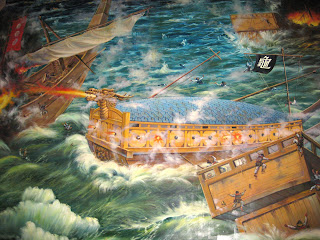 |
[left to right]
Democratic People's Republic of Korea leader Kim Il-Sung and Republic of Korea leader Syngman Rhee |
Liberation from Japanese control came after Japan lost World War II and forcibly accepted the Potsdam Declaration on August 14, 1945 (F). Shortly before and after this event, forces occupied North Korea on August 8, while US forces occupied South Korea on September 8 (F). The US had set up a military alliance with conservative South Korean politicians, while Soviets allied with communist North Korean forces. After many attempts, the US and former USSR failed to agree on plans for reunifying Korea. The issue was presented at the UN meeting, and elections were only held in South Korea, due to North Korea’s denial of the UN elections’ competency (F). South Korea then elected a National Assembly that later formed a democratic constitution. On August 15, 1948, Syngman Rhee, the first president of the Republic of Korea was elected(F). At the same time, ex-anti-Japanese guerrilla leader Kim Il- Sung controlled North Korea. While both North and South claimed to contain the only legitimate government of all Korea, the UN general Assembly acknowledged only the Republic of Korea, or South Korea, as the singular and official government of Korea (F).
On June 25, 1950, the Democratic People’s Republic of Korea invaded South Korea in an attempt to unify the peninsula under communist control(E). After advancing and taking over Seoul, the Republic of Korea’s capital, the UN Council declared the Democratic People’s Republic of Korea as the aggressor of the battle and ordered the troops to withdraw. Upon receive this news, US President Harry S. Truman ordered all US units to battle on June 30(E). Shortly after, the UN created a multinational command to join US troops in aiding the Republic of Korea. After disintegrating North Korea’s army, US General Douglas MacArthur drove his troops into North Korea, only to be engaged in battle by Chinese troops. China, who declared against the reunification of Korea by US and UN forces fought back until General MacArthur retreated and established the 38th parallel as the boundary between the Democratic People’s Republic of Korea and the Republic of Korea(E).
 |
| The 38th Parallel; The boundary line between North and South Korea. |
The end of the Korean War came on July 27, 1953, after the North Korean People’s Army, Chinese government volunteers, and Command at Panmunjom in the Democratic People’s Republic of Korea signed an armistice agreement(E). The Korean War cost about 415,000 South Korean lives, 23,000 American lives, and 3,100 UN ally lives(E). An estimation of 54,000 North Korean lives were officially reported lost, however, some also estimate almost 2 million lives lost(E). Through all the devastation, a conference regarding the reunification of Korea was held in 1954, however no agreement was reached(E).


